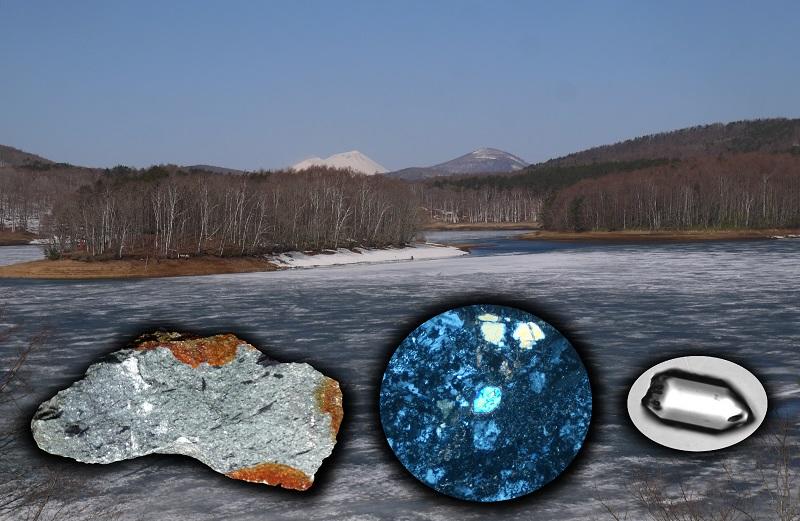Bulletin of the Geological Survey of Japan Top Page
Bulletin of the Geological Survey of Japan Vol.70 No.5 (2019)
Cover photograph | Table of Contents | Abstract
Cover photograph
Lake Gando against Mt. Iwate and zircon crystals in sandstone in the Jurassic accretionary complex
Lake Gando, whose flood area is c.a. 6 km2, was constructed for irrigation and hydro-electric generation in the Sotoyama district, eastern Morioka City, Iwate Prefecture. The mountains in the middle are, from left to right, snow-covered Mt. Iwate (alt. 2,038 m), an active volcano, and Mt. Himekami (alt. 1,124 m), which is composed of Early Cretaceous granite.
The basement around the lake consists of the Jurassic accretionary complex in the North Kitakami Belt. The inserted photos are, from left to right, a pale green sandstone (“Yonaigawa Sample”) in the Jurassic accretionary complex, detrital zircon in a thin section of the sandstone (crossed nicols), and a polished zircon grain for dating. The obtained youngest cluster U-Pb age is c.a. 190 Ma, middle Early Cretaceous (see Uchino (2019) in this volume). The length of the sandstone specimen and zircon grain is c.a. 10 cm and 100 μm, respectively.
(Photograph and Caption by Takayuki Uchino)
Table of Contents
All the pages PDF : 70_05_full.pdf [17MB]
| Title | Author | |
|---|---|---|
| Article | ||
| Whole-rock major and trace element geochemistry and geotectonic attribution of granitic rocks around the Higashigata, Akechi Town, Ena City, Gifu Prefecture, central Japan | Toru Yamasaki (p335-355) | 70_05_01.pdf [9.7MB]
Correction place: p. 346 l. 24 [Original] 第1表 [Correction] 第10図 December 13, 2019 |
| Detrital zircon U–Pb ages of sandstone within the Jurassic accretionary complex in the North Kitakami Belt of the Sotoyama District, Iwate Prefecture, Northeast Japan | Takayuki Uchino (p357-372) | 70_05_02.pdf [6.6MB] |
Abstract
Whole-rock major and trace element geochemistry and geotectonic attribution of granitic rocks around the Higashigata, Akechi Town, Ena City, Gifu Prefecture, central Japan
Toru Yamasaki
During the national mapping project for Quadrangle Series, 1:50,000, Akechi District, a granitic mass with 4 x 3.5 km in diameter at the Akechi Higashigata area, Ena City, Gifu Prefecture, central Japan was newly confirmed. The granitic mass is separated into Eastern and Western masses by overlying Akechi Conglomerate. Based on the results of whole-rock geochemical analyses, the Earstern Mass and Western Mass are correlate with the Busetsu Granite and Naegi-type biotite granite, respectively. The Busetsu Granite is characterized by relatively clear whole-rock geochemical trends and chondritenormalized rare earth element patterns showing gentle slopes up to the left with negative Eu anomaly.
On the other hand, the biotite granite shows rather scatterd whole-rock geochemistry and relatively flat rare earth element patterns with clear negative Eu anomaly. Most of the samples from the Busetsu Granite show higher alumina saturation index (>1.1) and fractionation of garnet from sediment-origin parental melt is suggested. On the contrary, the biotite granite show wide range of alumina saturation index due to heterogeneous assimilation of host pelitic metamorphic rocks. Although the parental magma of the Naegi-type granite (including biotite granite in the study area) has probably been similar to that of the metaluminous granites in the Ryoke Belt in the Chubu district, partial melting at shallower crustal condition has possibly resulted in SiO2-rich nature of the Naegi-type granite.
Detrital zircon U–Pb ages of sandstone within the Jurassic accretionary complex in the North Kitakami Belt of the Sotoyama District, Iwate Prefecture, Northeast Japan
Takayuki Uchino
U–Pb ages of detrital zircon from sandstone samples from the Jurassic accretionary complex
in the southwestern margin of the North Kitakami Belt in the Sotoyama District, Iwate Prefecture, were examined in this study. Four samples were collected at four locations from the boundary area between the North Kitakami and Nedamo belts to the northeastward: the Tatezawa, Yonaigawa, Okawa and Mukaizawa samples, respectively.
Zircon from the Tatezawa and Yonaigawa samples shows youngest cluster ages of c.a. 190 Ma, and
these sandstone samples probably deposit in the Early Jurassic. Zircon from the Okawa Sample shows
youngest cluster age of c.a. 260 Ma, and this sandstone sample probably deposit in the Late Permian, Late Triassic or Early Jurassic. Zircon from the Mukaizawa Sample shows a youngest cluster age of c.a. 170 Ma, and this sandstone sample probably deposit in the Middle Jurassic.
Geological Survey of Japan, AIST
- About GSJ
- Our Activities
- Purchase guide
-
Publications and Database
- information
- Bulletin of the Geological Survey of Japan
- bull2025(Vol.76)
- bull2024(Vol.75)
- bull2023(Vol.74)
- bull2022(Vol.73)
- bull2021(Vol.72)
- bull2020(Vol.71)
- bull2019(Vol.70)
- bull2018(Vol.69)
- bull2017(Vol.68)
- bull2016(Vol.67)
- bull2015(Vol.66)
- bull2014(Vol.65)
- bull2013(Vol.64)
- bull2012(Vol.63)
- bull2011(Vol.62)
- bull2010(Vol.61)
- bull2009(Vol.60)
- bull2008(Vol.59)
- bull2007(Vol.58)
- bull2006(Vol.57)
- bull2005(Vol.56)
- bull2004(Vol.55)
- bull2003(Vol.54)
- bull2002(Vol.53)
- bull2001(Vol.52)
- Bulletin of the Geological Survey of Japan(old)
- Annual Report on Active Fault and Paleoearthquake Researches
- Reports, Geological Survey of Japan
- CCOP-GSJ Groundwater Project Report
- CCOP Technical Bulletin
- Cruise Report
- Geological Hazards
- Learning and Education
- GSJ Database Collection
- Collection of links


